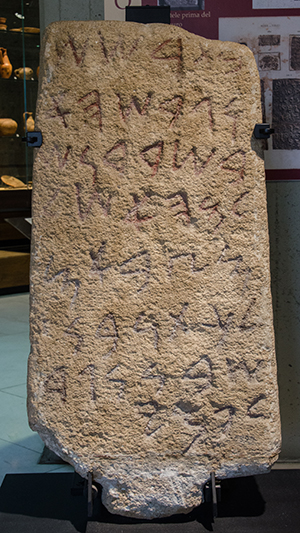More than 7000. That’s the number of living languages currently spoken in the world. More than half are presumed to lack a written counterpart, though that still lands the number of written languages at a staggering 2,800. The Bible alone has been translated into more than 2000 languages, making it the most universal and accessible book in the world. How did such linguistic diversity evolve from mere etchings in stone?

from 1200 BCE.
The earliest forms of writing date from the early Bronze Age, with Proto-Writing. This form of communication is referred to as “ideographic”, meaning it relies on the use of symbols to convey a message. Knowledge of a specific language is not required to absorb meaning from Proto-Writing; the etchings were comprehensible to anyone, allowing for easy communication between different peoples (which, in a time without Google Translate and domesticated animals, was greatly appreciated). As this writing continued to grow and become more sophisticated, inspired variations emerged. These included Egyptian hieroglyphs, Chinese logographs, and the earliest known writing system – Sumerian Cuneiform. Many of the early writing systems used clay tokens etched with symbols to represent different items, before evolving into etches of syllables and numbers as well – a prelude to the first alphabet.

Many consider Latin to be the mother of European languages. This is true to some extent – but the Phoenician alphabet must be acknowledged as the venerable yet largely forgotten great-grandmother in this metaphorical family of linguistics. As the oldest verified alphabet, Phoenician is phonetic and comprised of 22 consonant letters – mainly based on the Egyptian’s renowned hieroglyphics. Being “phonetic” means that each letter signifies a different sound. The Phoenician alphabet exemplified simplicity in its time; any word could be crafted with only a handful of inscriptions. Letters were marked with a stylus, which explains their generally angular design. This was later altered to become more rounded by popular demand across iterations. Originating in Phoenicia, merchants spread the written language throughout the Mediterranean, leading to its adoption and adaptation by several other peoples in the 9th century BCE. The prolific Arabic, Greek, and Hebrew alphabets were all derived from the great Phoenician predecessor.
The addition of writing didn’t render symbolism obsolete over the centuries. Symbolism is now arguably more abundant than ever, with its refined evolution of illustration playing a huge role in media and society. In addition, the rise of emojis over the past decade is indisputable, bringing humanity full-circle on the linguistic front. As people are increasingly (and perhaps alarmingly) communicating solely through the selection of emotes on their phone, a parallel can be drawn to our ancestor’s use of ideograms – the only difference being that while they were expressing vital tips on survival, we express our annoyance with the barista at Starbucks misspelling our name. Learning of the tumultuous road travelled to reach our current level of sophisticated written communication truly evokes gratitude to exist in a time where something as beautiful as writing is not only possible, but easy to use – allowing us to share even the most meaningless trifles, without requiring a slab of stone and a ton of patience.

Sources:
https://en.wikipedia.org/wiki/Phoenician_alphabet
https://en.wikipedia.org/wiki/History_of_writing
https://usefulcharts.com/blogs/charts/evolution-of-the-english-alphabet
https://commons.wikimedia.org/wiki/File:Shang_dynasty_inscribed_tortoise_plastron.jpg